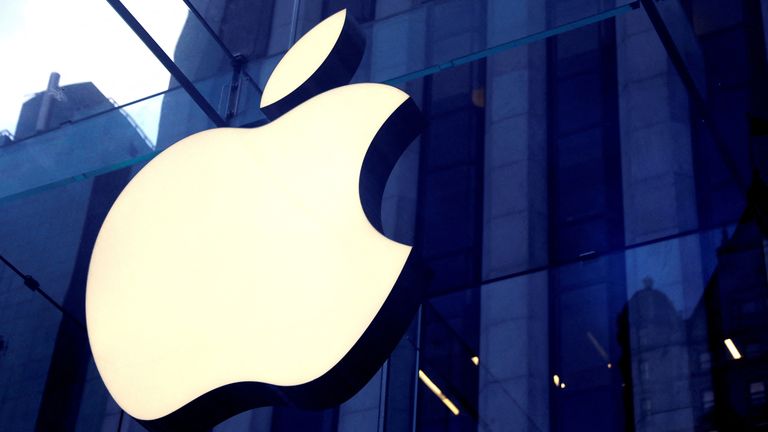
The world’s largest company’s sales exceed expectations, particularly for the iPhone, as some buyers wait for an upgrade, while Amazon fails to excite despite growth.
After a mixed fortnight of trading statements from the US IT titans, it was up to the biggest of them—Apple—to boost investor confidence.
In June, the $3.35 trillion (£2.63 trillion) corporation regained its position as the world’s largest company following a five-month gap with Microsoft. Sales for the three months ending June 30th were $85.78 billion (£67.32 billion).
That was up slightly less than 5% from the same quarter last year, and it was above Wall Street’s expectations of $84.53 billion (£66.34 billion).
iPhone sales, which account for nearly half of Apple’s income, exceeded estimates, totaling $39.3 billion ($30.84 billion).
That was down 0.9% from the same period last year, but better than the predicted 2.2% fall.

That will be viewed as a resilient performance—it was certainly better than Apple’s own management had anticipated—given that Apple is preparing to unveil the iPhone 16 in September, and some customers will be holding off on replacing their previous smartphone.
The next iteration is planned to include more new capabilities powered by artificial intelligence.
Dan Ives, managing director at Wedbush Securities and one of Wall Street’s most well-known tech analysts, estimates that over 270 million iPhone owners have not upgraded their handset in the last four years, potentially making this the most significant iPhone launch in many years.
Among other highlights in the latest figures was the performance of Apple’s services division, which includes its app store, Apple Pay, Apple Music, iCloud, and the Apple TV+ streaming service, which generated $24.2 billion in revenue during the quarter, a 15% increase over the same period the previous year.
‘Consistent Growth’
According to Antonio Ernesto Di Giacomo, a senior market analyst at XS.com, the company’s revenue diversification relies heavily on the continued expansion of its services area.
“The increase in this area reflects Apple’s strategy to expand its service ecosystem and build customer loyalty with an integrated and varied offering.”
Another surprise in the data was how well the iPad, which is sometimes unfairly viewed as a Cinderella product when compared to the flagship iPhone, performed during the quarter.
Sales increased by 24% to $7.2 billion in May, after new product releases.
Blemish
If there was an issue with the results, it was most likely in Greater China, Apple’s third-largest market after the Americas and Europe.
Sales totaled $14.72 billion, a 6% decrease from the same period a year ago, highlighting fierce rivalry from local rival Huawei, whose foldable smartphones and products have been popular among Chinese consumers.
Apple has been compelled to offer price discounts in the country in order to compete with its less expensive competitors.
Amazon’s quarterly revenue fell short of Wall Street projections for the first time since October 2022, but Apple’s results pleased tech investors.
Amazon shares slumped 8% in after-hours trading after sales for the three months ending June 30 totaled $147.98 billion, up 10% from the same time a year ago but $580 million below what Wall Street expected.
When seen in isolation, the data were not too bad, but what appears to have damaged Amazon was that expectations were very high, with the shares having increased by 20% this year heading into the results.
As a result, even if sales at the company’s widely monitored cloud segment, Amazon Web Services (AWS), increased 19% to $26.3 billion, this was viewed as a disappointing performance in comparison to competitors.
Slowdown
Microsoft’s Azure platform, for example, announced 29% growth for the quarter on Tuesday evening, which was viewed as disappointing at the time due to a drop from the previous quarter’s 31% growth rate.

During this time, despite the fact that Amazon’s main e-commerce sector experienced an increase in revenue—the company’s largest division, online stores, increased by 5% to reach $55.4 billion—this was also seen to be somewhat disappointing.
Those who have invested in the company are concerned that it will be confronted with increased competition from Chinese companies like Shein and Temu.
The guidance for the following quarter, which appeared to fall short of expectations once again, was another source of disappointment.
Uncertainty regarding investments in AI
One of the most significant challenges that businesses like Amazon are facing is that, despite the fact that they are currently making significant investments in artificial intelligence (AI), investors are growing increasingly concerned about the amount of money that is being invested and are concentrating more on the returns that are being created by that investment than they did just a few months ago.
The massive sell-off that occurred after hours in Intel, which resulted in a 21.5% decrease in the company’s share price, was likewise centered on this particular factor.
Pat Gelsinger, the chief executive officer, has said that the business intends to save ten billion dollars through a variety of methods. These measures include eliminating the dividend that the company pays out, reducing investment, and reducing Intel’s global workforce by fifteen percent, which is equivalent to approximately seventeen thousand and five hundred jobs.
Competitors
Intel has been subjected to challenging comparisons with competitors such as Nvidia, which is widely regarded as the industry leader in artificial intelligence chips, and Advanced Micro Devices, to which it has been consistently losing market share in traditional chips.
All of this culminated in a reporting season that was fairly uneven for the major tech companies.
Apple, Alphabet, and Meta platforms were among the so-called “magnificent seven” that surprised to the upside, while Microsoft, Amazon, and Tesla were among the platforms that proved to be slightly disappointing.
Once again, the focus shifts to Nvidia, which is scheduled to release its subsequent findings on August 28th, covering the period beginning on July 28th.